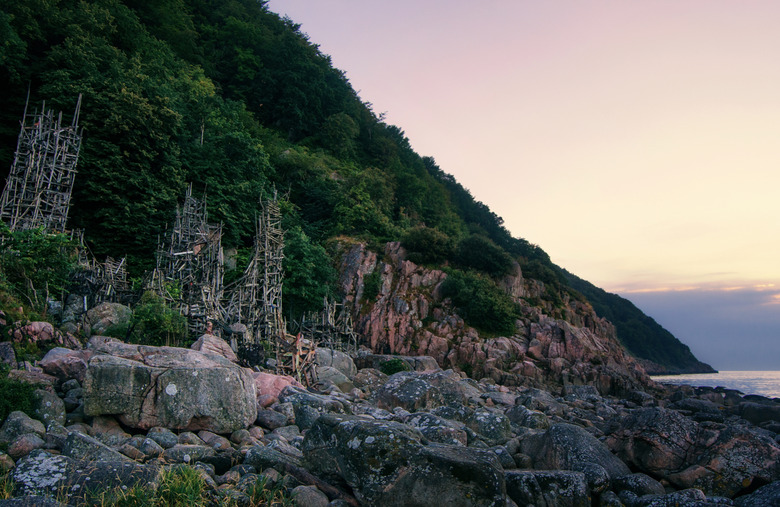This Country With Over 18,000 Citizens Is Literally Just A Pile Of Sticks
For over a decade now, the one-square-kilometer (approximately 0.39 square miles) micronation of Ladonia has sat on a peninsula in southern Sweden, little more than an intricate construction of driftwood art. Complete with its own time zone (Ladonia Standard Time, just three minutes behind Sweden) and its own currency, the örtug (approximately 1 euro or 10 Swedish krona — $1.25 U.S.), Ladonia is a constitutional monarchy with a national anthem that is the sound of a stone being thrown into water.
If you wish to visit Ladonia, you may find it difficult, as there are no signposts or maps marking its location, much like the village of Yaohnanen of Prince Philip-worshiping fame. Located on the peninsula of Kullaberg, present-day Ladonia has 17,752 citizens, 841 nobles, and 125 ministries, but zero inhabitants. Approximately 40,000 people make the two-and-a-half-kilometer trek to visit the micronation every year, however. Queen Carolyn I is the reigning monarch, and the country also has an actual president, vice president, and state secretary.
On its website, the country refers to itself as "The Proud, Free, and Interactive Micronation," hinting at a history that is far more interesting than one might think. In 1980, artist Lars Vilks made two sculptures in the Kullaberg nature reserve, one made of driftwood called Nimis and one made of stone called Arx.
Due to the obscure location, the sculptures remained untouched until their discovery two years later, upon which the local council ordered that they be removed, as construction on the nature reserve was forbidden. Thus began a legal back-and-forth between Vilks and the council, during which Nimis was dramatically set ablaze and two-thirds of it destroyed in 1985.
Over the next decade, Vilks was finally convicted and fined for building the sculptures. On June 2, 1996, Vilks declared the territory on which his artwork stood to be the micronation of Ladonia. The country soon began accepting citizenship applications — which it does to this day —and formed a parliament, with Vilks himself as chancellor.
By the next year, the nation had amassed over 1,000 citizens and the first Ladonian election was held in order to decide its system of government. Citizens voted for a constitutional monarchy in which Ywonne I Jarl was made queen and Fernando Rodrigues of Brazil was made the country's first president.
Since then, the country has continued to have a hilariously colorful history, all chronicled on its official website. Its chancellor, Lars Vilks, continued to get into trouble with the law, and in 2003, the nation declared war on Sweden, the United States, and San Marino (although the causus belli was not entirely clear).
In 2011, Queen Ywonne I disappeared, and after an extensive search for her, the Ladonian Cabinet of Ministers decided to remove her and her line of succession from the throne, after which further candidates were nominated and an election for the new Queen was held. June 2, 2011, saw the 15th anniversary of the nation's founding, as well as the election of Queen Carolyn I, who had an actual coronation on Sept. 19 at Nimis in the presence of Swedish media as well as Ladonia's state secretary, the new royal family, and the "Minister of Art and Jump."
If you'd like to become a citizen of Ladonia, you can do so for free online, although there is a $30 fee to apply for a title of nobility. The country's website has all kinds of information regarding its government and history, including its ancient history and creation myths. It also has the Ladonian Calendar, which includes holidays, such as its Independence Day and the birthdays of the current and former queens, as well as more whimsical observances such as the Day of Procrastination, Naked Day, the Day of Artful Jumps, and the Day of Throwing Things at Each Other. If you think Ladonians are the only ones with goofy holidays, however, think again: Here are twelve of the most pointless food holidays we celebrate here in the U.S.
